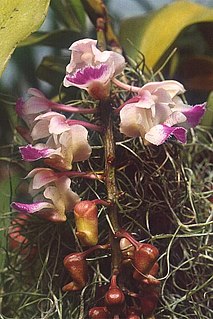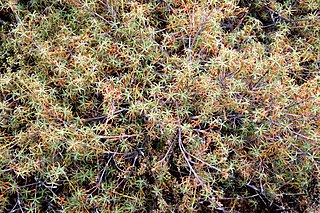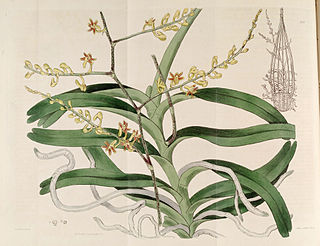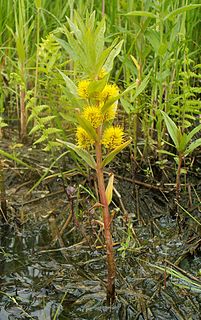Related Research Articles

In the botanical classification of plants, Aeridinae is a subtribe of the Tribe Vandeae whose representatives all have a monopodial growth habit and do not possess pseudobulbs.
This article gives an overview of the mire communities in the British National Vegetation Classification system.

Leptospermum recurvum is a species of shrub or tree that is endemic to Mount Kinabalu in Malaysian Borneo. It has pale, flaky bark, broadly elliptical to almost round leaves, white flowers about 12 mm (0.47 in) wide and fruit that tend to remain on the plant for a year or two.
NVC community M2 is one of the mire communities in the British National Vegetation Classification system.
NVC community M4 is one of the mire communities in the British National Vegetation Classification system.

Dracophyllum recurvum, known commonly as curved leaf glass tree or neinei is a prostrate to semi-erect shrub belonging to the genus Dracophyllum.

Cleisostoma is a genus of orchids with approximately 90 accepted species widely distributed through much of the Indian Subcontinent, Southeast Asia, China, New Guinea, and some of the islands of the Western Pacific.

Lysimachia thyrsiflora, the tufted loosestrife, is a plant in the genus Lysimachia. It is native to large sections of the northern Northern Hemisphere, including Eurasia and North America. It often grows in marshes, shorelines of lakes and ponds and occasionally along streams. It is an erect perennial herb growing up to 80 centimeters tall and bearing yellow flowers, sometimes dotted with purple. It may be confused with purple loosestrife when not blooming but can be easily distinguished because purple loosestrife has a square stem. Tufted loosestrife has been used medicinally in Asia to combat high blood pressure.

Cleisostoma paniculatum is a species of orchid found in India, Assam, Bhutan, Taiwan, Thailand, Vietnam, and China.

Cleisostoma rostratum is a species of orchid found in Cambodia, Laos, Thailand, Vietnam and China.

Cleisostoma simondii is a flowering plant that grows upon larger trees, and known in Hong Kong as (Chinese:蜘蛛蘭). It also occurs in the Himalayas, Cambodia, Laos, Myanmar, Thailand, Vietnam, and other parts of China.
Schistotylus purpuratus, commonly known as purple sprites, is the only species in the genus Schistotylus from the orchid family, Orchidaceae. It is a small epiphytic orchid with up to six crowded, linear leaves and up to ten cup-shaped, pale green flowers with purple marking and a mostly white labellum. It grows in rainforest and swampy heath in eastern Australia.
C. paniculatum may refer to:

Plectorrhiza tridentata, commonly known as the common tangle orchid, is an epiphytic or lithophytic orchid that has many coarse, tangled roots, up to twenty egg-shaped leaves and up to fifteen green or brown, star-shaped flowers with a white labellum. It grows on rainforest trees and in other humid places and occurs between the Daintree National Park in Queensland and the far north-eastern corner of Victoria.
Cleisostoma williamsoni is a species of orchid. It is found in Asia.

Wellington College Bog is a 6.2-hectare (15-acre) biological Site of Special Scientific Interest in the grounds of Wellington College on the northern outskirts of Sandhurst in Berkshire.
Cleisostoma aspersum is a species of orchid found in Bhutan, India, Myanmar, Thailand and Vietnam.

Cleisostoma crochetii is a species of orchid found in Vietnam, Cambodia and Laos.
Cleisostoma sagittatum is a species of orchid found in Borneo, Java, the Philippines and Sumatra. This species was first described by Blume in 1825.
Sphagnum recurvum is a species of moss belonging to the family Sphagnaceae.